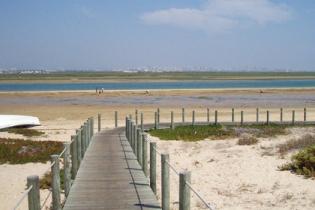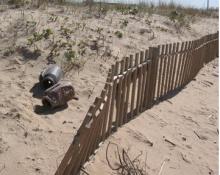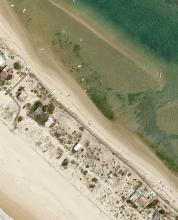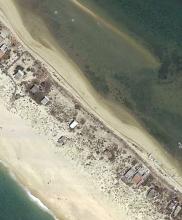
For the rehabilitation of a dune system, an elevated wooden pathway over the shore and the dunes and a dune fence were created. They were created to restore the physical and ecologic characteristics of the dunes at a natural Park at Praia de Faro (Portugal). The cost effectiveness is analyzed in this description and compared to beach nourishment.
Based on the RISC-KIT Case Study Ria Formosa, Portugal
Impacts/Problem
Praia de Faro is a coastal area in the South of Portugal which is close to the city of Faro which is home to a small community of fishermen and used as a recreational area for tourists and locals. The area is a narrow dune strip between the Atlantic and Ria Formosa coastal lagoon, situated between the oceanic shore and the back barrier beach. Praia de Faro is affected by coastal erosion from storms as well as by human interventions that alter the natural behaviour of the area, e.g. the use of (summer) houses and trampling paths, crossing the dune. The houses have direct access to the oceanic shore, by crossing the dune. Consequently, human interventions had reduced vegetative cover increasing the sand loss with notable dune destruction due to trampling.
Measure description
The analysed measure was implemented from 2000 to 2001 and included two different main actions: a) construction of an elevated wooden pathway along the shore and across the beach area over a length of approximately 1500 m; b) creation of dune fences (1 km in one row and ~500 m of reticulated fences).
The elevated pathway was built facing away from the shoreline, and was therefore close to the back barrier beach. It has two accesses to the shore, one at the beginning of the pathway (to the west) and another almost at the end (to the east). This allows people to access the beach without stepping over the dune. Access to the ocean shore from the individual houses and the old trampling pathway were removed and closed. Here, it is also notable that the summer houses lying on the dune front were also removed from the dune section (on separate interventions). The house removal is not analysed as part of the measure since it was undertaken independently from the construction of the pathway and much more recently.
The fences led to an increase in the dune’s height and width, with an increase of more than 1.3 m in elevation and an advancement of between 0 and 10 m. Due to the limited height of the fence, a further increase in the dune height is not expected and would only be possible with the use of additional, higher fences. Based on the existing situation, however, the dune will be maintained for decades if extreme storm events and major human interventions do not take place.
Another direct impact of the measure is the reduction of overwash incidents in which ocean water and sediment pour over the dune, with no water flowing back through and returning to the ocean. This is also closely interlinked with sand loss, which happened regularly at the western part of the analysed area. No episodes of overwash incidents and shoreline retreat where recorded at the area since the measure was implemented.
The measure has also reduced the number of trample paths from more than 10 before the measure was implemented, to less than five observed in 2013. Reduced foot traffic and usage has enabled a recovery of vegetation on the old trample path and paths to the ocean shore. At the frontal dune, the vegetation density is higher than 25%, which is close to natural values. Furthermore, natural (autochthone) species dominate the vegetation.
Based on the observed effects and the cost estimates relating to the increase height and width of the dune, it can be estimated that costs of the measure per additional m3 dune are about 62 to 74 Euro/m3. To compare with other measures achieving similar effects, we assume a conservative 40 year lifetime of the measure, which results in a cost effectiveness value of approximately 1.50 to 1.85 Euro/m3/year.
In the literature, several measures exist which aim to prevent or minimize coastal erosion, such as sea walls or beach nourishment. Because of its status as a natural reserve area it is not allowed to built new sea walls or groynes at that area, therefore these measures are not considered here. Beach nourishment would be a considerable measure, but it has to be mentioned that the objective of beach nourishment and building the wooden path and fences implementation are reasonably different. Beach nourishment is a measure which can cost approximately 2 and 180 Euro/m3 depending on the situation. In Praia de Faro it costs around 6 Euro/m3. An average time for further major recharges is about 5 years. To compare the different values we estimate the yearly costs as well. The measure has a general cost-effectiveness between 0.40 and 3.50 Euro/m3/year, specific for Praia de Faro 1.20 Euro/m3/year. The estimation shows that the cost-effectiveness of the wooden path and fences are in average comparable to beach nourishment. The further benefits associated to the wooden path and fences are not included in the estimation.
Further benefits
Alongside the main objective of the measure - the physical and ecological recovery of the dune - additional positive effects and ‘co-benefits’ were created as a result of the measure’s implementation. For example, locals and tourists benefit from improved and faster access to the dune, houses, and shoreline beyond the dune (often frequented by surfers) due to the elevated pathway. Motorbikes can now be used by the local residents, which reduce commuting time between locations and improve access to emergency services via use of the pathway, should they be necessary. More concretely, the time to cross the 1.5 km stretch was decreased from more than 25 minutes walking to 5 minutes by bike (keeping in mind that biking was not possible previously). Furthermore, the tourists and locals have increased their use of the area for recreational enjoyment due to this improved access, leading to a likely increase in revenue to the bars and restaurants in the direct vicinity.
Even though the initial costs of this measure were relatively high, the measure can be considered as cost-effective because of its relatively long life duration (ca. 40 years) and low maintenance costs. Additionally this measure has co-benefits that were not calculated in the cost-effectiveness analysis (e.g. biodiversity conservation or recreational opportunities). In comparison with hard structural coastal defense measures, this approach has almost no negative side-effects.














